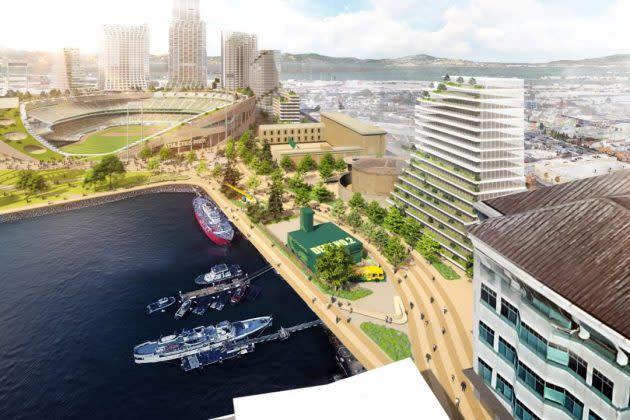MLB Tells Oakland A’s to Seek Relocation Amid Stadium Approval Push

Major League Baseball has given the Oakland A’s permission to begin seeking relocation options while the team is still pursuing a new $1 billion ballpark on the waterfront at Howard Terminal west of downtown Oakland.
The A’s have a lease to play at the Coliseum through the 2024 season, and need a resolution of the situation by then, club president Dave Kaval said in an exclusive interview. After that, the A’s won’t continue to play at the Coliseum or in a new ballpark on that site.
“There’s not an option to build at the Coliseum site,” Kaval said. “It’s not a site that’s viable for 21st century baseball. We’ve been saying that for a long time, but the commissioner [Rob Manfred] has also said that. I think it’s important for people to understand that if it’s in Oakland it’s either Howard or bust.”
MLB reiterated that position Tuesday. “The Oakland Coliseum is not a viable option for the future vision of baseball,” MLB said in a statement.
The option for the team to move is the first time that prospect has been explored. Since 2007, new ballpark proposals have failed south of the Coliseum in the cities of Fremont and San Jose, and later in downtown Oakland at Laney College.
The Howard Terminal site is the latest on the docket. It has faced some fierce local opposition even though the area is moribund and the A’s have told the Oakland City Council they will privately fund a phased-in $12 billion real estate deal with the new ballpark opening first. A public comment period on the site’s environmental impact report ended in late April.
Kaval said the A’s intend to fund the cost of the ballpark with other partners eventually joining in the multi-use part of the project. The A’s proposed that the city pay for infrastructure costs by raising tax revenue from a district created around the site.
Kaval said the A’s don’t want to move. They are “rooted in Oakland” after the NFL’s Raiders left Oakland for Las Vegas and the NBA’s Warriors shifted operations to the Chase Center in San Francisco.
“We’re really hopeful that the City Council will take up a vote by the summer recess, which is mid-July,” Kaval said. “We’ve been working almost five years in Oakland on a downtown ballpark. Our original site didn’t work at Laney College. We moved to the waterfront with a $12 million project there we think is really dynamic. We just really need some indication from the Council that it makes sense for the city.”
MLB, though said, it’s “concerned with the rate of progress” on that project. Noting that the A’s need a new ballpark to remain competitive, the commissioner’s office added that it’s “now in our best interest to consider other markets.”
What market that might be is still up to conjecture.
“It’s really too premature to say,” Kaval said. “We’re going to work with the league to see which ones make the most sense. Theoretically it’s going to be in the western area. But I think anything is possible. We’ll just take direction from the league.”
MLB has only allowed one franchise to move since the Washington Senators left for Texas in 1971, and that was the Montreal Expos, who fled Canada and returned baseball to the nation’s capital after the 2004 season.
Unlike the other major sports, MLB enjoys a partial exemption from antitrust laws, which allows baseball owners to control franchise movement. A total vote of 75% of the 30 owners is needed for a franchise to leave its current market.
Periodically, both the A’s and San Francisco Giants have threatened to leave the San Francisco Bay Area, where the Giants are entrenched at what it is now called Oracle Park. The Giants nearly moved to Toronto in 1976 and Tampa Bay in 1992. On both occasions, the franchise was saved by an ownership change.
The A’s nearly moved to Denver in 1978, but that move was thwarted when Charles O. Finley sold the club to local interests.
The A’s have played at the Coliseum since moving west from Kansas City in 1968. The Coliseum is the third oldest ballpark in the American League behind Boston’s Fenway Park and Angel Stadium in Anaheim.
As far as relocation sites in the west, Portland and Las Vegas might be the only viable options, and in both places new ballparks would have to be funded and built to the same tune of about $1 billion. Montreal has been mentioned as sharing the Tampa Bay Rays, the other team that has been facing chronic long-term stadium issues in its home territory. The Rays, though, have an ironclad lease to play their full home schedule at the Tropicana Dome in St. Peterburg through the 2027 season.
The A’s could first be on the move.
“We’re still hopeful we can get a deal in Oakland,” Kaval said, “but we’re realistic in understanding that our timelines have been slipping, and we’re running out of time in our existing facility that’s really a relic from a previous century. We need closure by 2024, and keep in mind that any option in any location will probably take longer than that.”
More from Sportico.com
